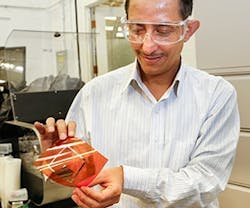HVAC Sensors and Controls to Cut Building Energy Use
Research shows that the use of advanced controls and sensors for HVAC systems could save up to 20-30% of building energy consumption and while options are available, most must be wired-in or are cost-prohibitive. Researchers at the DOE’s Oak Ridge National Laboratory are looking to change all of that by developing new wireless node sensors with a lower production cost.
With current wireless node sensors costing up to $150-300 per unit, the ORNL team expects that their prototype sensor will make the technology more affordable by cutting costs by around $1-10 per node, using new construction techniques like additive roll-to-roll manufacturing. The node components are printed onto flexible plastic substrates and are installed without wires using adhesive backing. The sensors provide more accurate temperature information to the system that is working, allowing it to use power more intelligently. The smart sensors are designed to work in both new and retrofitted buildings, and ORNL is currently looking for a corporate partner to help bring the sensors to market.
“If commercially available at the target price point, there would be endless application possibilities where the installed cost to improve the control of energy-consuming systems would pay for itself through lower utility bills in only a few years,” says Patrick Hughes, director of ORNL’s Building Technologies Program.
Looking for more ways to cut HVAC expenses? Take a look at these 5 Ways to Maximize Your Economizer Efficiency.
